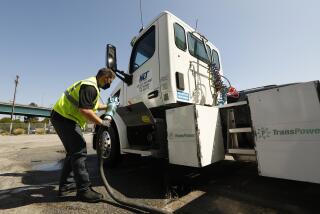Toyota’s Truck Unit Plans to Deliver Bigger U.S. Sales
- Share via
In the commercial delivery truck business, American manufacturers dominate.
After years of nibbling at the market, Japan’s Toyota Motor Co. wants to take a much bigger bite. Executives at Toyota’s Hino Motors truck unit plan to double the company’s U.S. market share in the coming year and to quintuple sales here in a few years.
As part of the expansion plans, Hino is assembling medium-duty trucks in the U.S. for the first time at a facility in Long Beach. Toyota’s Hino Motors Manufacturing USA unit recently opened a $30-million parts, logistics and corporate headquarters center in Ontario. And the company is building a parts distribution center in Arkansas that may add manufacturing capacity if Hino’s U.S. sales grow.
“We have 1% of the market now, and we want to get to about 5%,” said Derek Kaufman, senior vice president of Hino Motors Sales USA.
If that sounds optimistic, he advised people to remember that Toyota three decades ago had just 1% of the U.S. car market. Now it’s 12%, which Toyota has claimed largely at the expense of Ford Motor Co. and General Motors Corp.
Despite Toyota’s great success in cars, some analysts are shaking their heads about Hino’s goals for the U.S.
“For Hino to think it can double its sales in just one year seems a little aggressive to me,” said Ken Kremar, a commercial truck industry analyst with economics research firm Global Insight. “Most of the brands are pretty entrenched.”
Hino sold just 1,741 trucks in the U.S. in the first nine months this year, and its annual market share rarely hits 1%. Ford, the industry leader with a share of about 25%, sold 45,510 units through September. Other dominant players: Navistar International Corp., DaimlerChrysler’s Freightliner and General Motors’ GMC brand.
“Taking share away from them is going to be difficult,” said Eli Lustgarten, an analyst with J.B. Hanauer & Co.
Another challenge for Hino is that within the medium-duty truck market, being a Toyota product doesn’t have quite the same cachet as in passenger cars. “Quality is pretty high all around” among truck manufacturers, Lustgarten said.
Undaunted, Hino Chairman Tadaki Jagawa said in a recent speech at the Long Beach assembly plant that he wanted to sell 2,000 trucks in the U.S. this year, double that to 4,000 next year and then see sales soar to 10,000 in 2006.
Worldwide, Hino is a bigger name. Last year the company sold 87,000 trucks and buses and had revenue of $10 billion, making it the world’s 10th-largest commercial truck builder. Toyota first invested in Hino in the 1960s and acquired controlling interest in 2000.
Customers for Hino’s trucks, all of which are diesel-powered, vary from small retail stores to giant manufacturing companies. Some, such as Penske Truck Leasing, may buy 100 trucks at a time. The trucks are used for hauling just about anything that can fit inside: computers, boxes of men’s socks, construction tools and toys.
To help launch its assault on the U.S. medium-duty truck market, Hino abandoned its “cab-over” truck design in favor of a line of more conventional trucks.
A cab-over truck features a passenger cabin sitting atop the engine. In a conventional truck, the engine is under a hood in front of the passenger cab.
The drawback with cab-over trucks is that the entire cab must be tilted forward to get to the engine, which adds costs to even routine service, Kaufman said. It also limits their appeal. The market for cab-over trucks accounts for just 8% of the medium-duty truck segment in the U.S.
“With our new [conventional] trucks, we see ourselves addressing 80% of the market,” he said.
Hino’s prices range from $30,000 for a truck that can haul 5,000 pounds of cargo to $60,000 for a beefier truck able to carry about 17,000 pounds.
The company’s prices are competitive, said Lustgarten, but profit margins are thin throughout the industry. Truck makers’ real earnings come from service and parts sales during the 10- to 12-year life span of each vehicle.
Much of Hino’s growth strategy hinges on its Long Beach assembly plant, where workers also manufacture catalytic converters and steering columns for Toyota cars. Truck parts from domestic and Japanese suppliers are collected at the Ontario logistics center and trucked to Long Beach.
Building trucks in the U.S., Kaufman said, has enabled Hino to switch to American-built drivetrains and suspensions.
“That means new customers can integrate spare parts they already have on hand, instead of having to buy Japanese parts,” he said.
Hino still uses Japanese engines, though, and that could be a plus as U.S. emissions regulations for diesel trucks tighten in 2007. Many truck engine makers say meeting the new standards will be difficult and costly.
But Hino trucks already use advanced fuel injection, exhaust and turbocharging systems for emissions control and are likely to be able to meet the new standards with relative ease.
Barbara Boardman, sales manager for the Don Kott Truck Center dealership in Carson, also sells Ford and Isuzu trucks. One of Hino’s strengths is its commitment to customer service, she said. “I’d rate them an 8 on a scale of 1 to 10.... Domestic companies are probably 3s.”
Boardman isn’t convinced that Hino will meet its sales goals as quickly as the company wants. But she has no doubt about the end result.
“They’re like Toyota,” she said. “They don’t announce a goal unless they know they can accomplish it.”
*
(BEGIN TEXT OF INFOBOX)
Far behind
U.S. sales of medium-duty commercial trucks at Hino and the top four makers in the first nine months of 2004 (in thousands)
Hino: 1.7
GM: 23.7
DaimlerChrysler: 39.3
Navistar International: 39.8
Ford: 45.5
Source: Ward’s Automotive Reports






